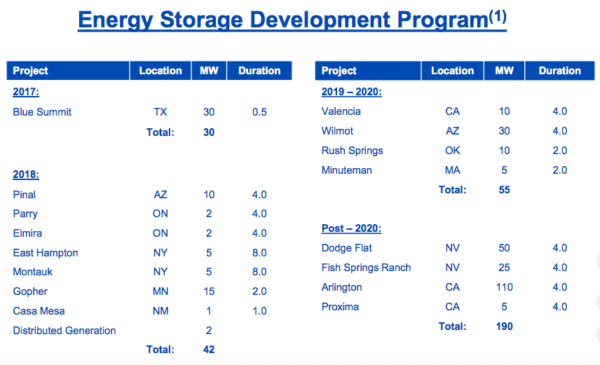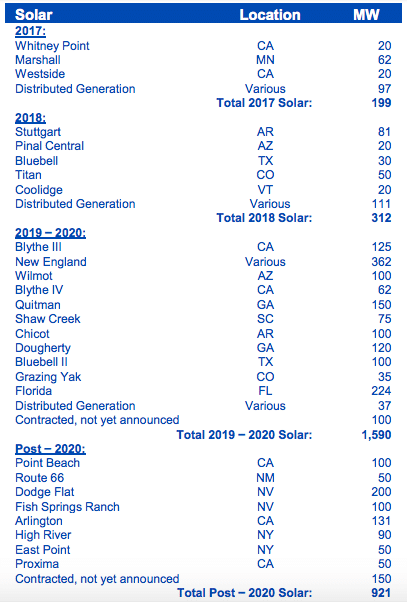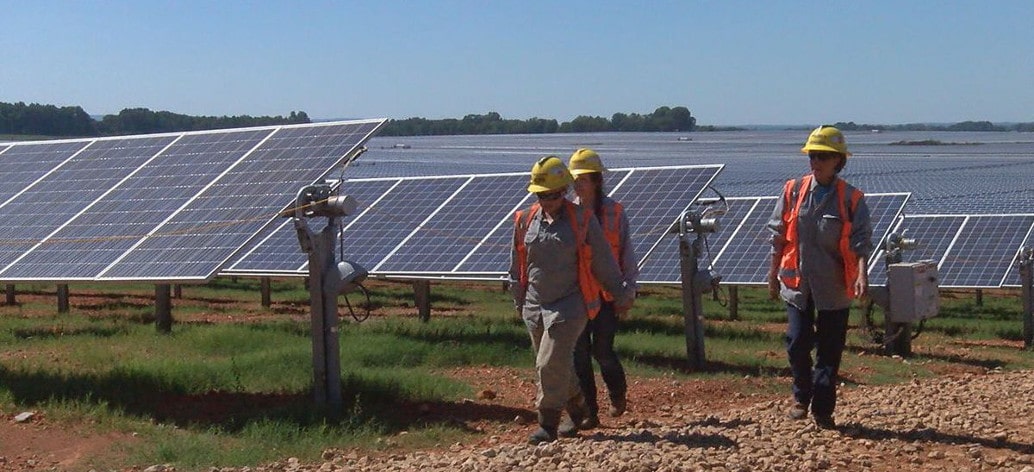While traditional power companies have often resisted renewable energy and continue to consistently resist customer-sited solar, they are also some of the biggest players in building the large-scale wind and solar which is increasingly dominating new generation in this country.
And in the renewable energy development game, there is nobody bigger than NextEra. It helps that it was early; long before other big power companies got into renewables, NextEra invested in a series of concentrating solar power (CSP) plants in Southern California that were built in the 1980s.
In the second decade of the 21st century this has meant solar PV and wind, not CSP. And while the company’s development arm built 554 MW of wind and solar in 2017 alone, this was just the beginning. Accompanying its third quarter 2018 results, released today, NextEra announced that it has completed its most successful quarter ever for renewable energy origination, adding 2.1 GW of renewable energy its backlog.

This includes not only 447 MW of solar but also 120 MW of battery storage projects. These new projects mean that NextEra Energy Resources now has 511 MW of signed contracts from projects due in the 2017-2018 time period. But it is in 2019-2020 that activity really kicks off, with another 1.6 GW of solar projects coming due. As some projects will either be shelved or sold off and others will be added, NextEra expects to develop anywhere from 1.4 – 3.8 GW of solar from 2017 through 2020.
Despite the impacts of the Section 201 tariffs – which appear to have already been offset by cost reductions – NextEra President and CEO Eric Silagy described the current situation as “the best renewable energy development environment environment in our history”.
“The scale of origination success that we have had this year reflects the increasing demand for low-cost solar and wind energy projects,” noted Silagy on the company’s results call. He also noted that the 2.1 GW added to the company’s backlog is larger than the company’s entire operating portfolio was in 2011, and in particular commented on the “disruptive” nature of low-cost solar.
Big plans post-2020
NextEra is also moving into battery storage in a big way. The company claims 127 MW of battery contracts already signed, but has identified 160 MW of battery projects to be developed over the next three years, in addition to the 30 MW that it built last year.

This of course is only through 2020; NextEra also claims 921 MW of solar and 190 MW of storage projects planned for post-2020 delivery. It is unclear how many of these will be paired; however NextEra has already made headlines for building the United States’ largest solar + battery project, and notes that during the quarter it signed a contract to add wind to the Babcock Solar Ranch project.
Additionally, the company does not expect the cost of pairing these two resources to be prohibitive, and has suggested that adding battery storage to solar projects will only increase costs by half a cent per kilowatt-hour by the mid-2020s.
 As may be expected from the largest wind and solar developer, NextEra is also showing a high degree of geographic diversity with its fleet. The company has solar projects in California, the Mountain West, the South and Northeast, as well as building a solar plant in Minnesota last year.
As may be expected from the largest wind and solar developer, NextEra is also showing a high degree of geographic diversity with its fleet. The company has solar projects in California, the Mountain West, the South and Northeast, as well as building a solar plant in Minnesota last year.
During its particularly busy 2019-2020 time period NextEra has a number of projects due in the U.S. South, with six projects in five Southern states, but also 362 MW of solar in New England. After 2020 the projects are largely in the West and Northeast, with two projects under contract in New York.
The company has done all of this while remaining profitable, both through its renewable energy development arm as well as Florida Power and Light, its utility arm. And while all of the numbers cited so far are only for NextEra Energy Resources, FPL is also building four large solar projects totaling nearly 300 MW throughout Florida, and the company notes that it has secured sites that could host as much as 6 GW of solar.
This content is protected by copyright and may not be reused. If you want to cooperate with us and would like to reuse some of our content, please contact: editors@pv-magazine.com.









By submitting this form you agree to pv magazine using your data for the purposes of publishing your comment.
Your personal data will only be disclosed or otherwise transmitted to third parties for the purposes of spam filtering or if this is necessary for technical maintenance of the website. Any other transfer to third parties will not take place unless this is justified on the basis of applicable data protection regulations or if pv magazine is legally obliged to do so.
You may revoke this consent at any time with effect for the future, in which case your personal data will be deleted immediately. Otherwise, your data will be deleted if pv magazine has processed your request or the purpose of data storage is fulfilled.
Further information on data privacy can be found in our Data Protection Policy.